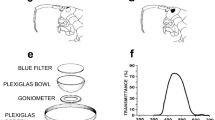Summary
In the compound eye of Stylops a “crystalline cone” of the pseudocone type is found beneath the corneal lens. It is enveloped by several pigment cells. At the proximal part of the cone there are 6 cells (Semper cells) mostly pigment-free.
The ommatidium consists of approximately 60 retinula cells. Their rhabdomeres distally rim-like connected to another form a single “open” rhabdom which encircles extracellular granular material as well as the bases of the Semper cells. Here and there the rhabdom plus granular material is overlain with distal protrusions of single retinula cells which appear to be homogeneous. Towards the proximal part the rhabdom increasingly divides up into smaller rhabdomal segments. One or two conspicuous large retinula cells were found in the central part of the ommatidium, appearing to be less electron-dense and containing pigment granules of a smaller size. Each ommatidium is surrounded by numerous cells (Stützzellen) lacking in pigment. These cells are partially insulated from another—as well as the basal parts of retinula cells—by protrusions of glia cells.
Our investigations show that the eyes of Stylops (as a representative of Strepsiptera) are not of the “ocellar complex eye” type. At least the structure of the rhabdom resembles to that of the larval eye (stemma), the receptor part of which is not reduced in the imago.
Zusammenfassung
Unter den Cornealinsen des Komplexauges von Stylops befindet sich ein „Kristallkegel“ vom pseudoconen Typ, der von zahlreichen Pigmentzellen umhüllt wird. An seinem proximalen Ende liegen 6 meist pigmentfreie Zellen (Sempersche Zellen).
Das Ommatidium besteht aus etwa 60 Retinulazellen. Ihre distal kranzartig miteinander verbundenen Mikrovillisäume bilden ein einziges „offenes“ Rhabdom, das extrazelluläres (?) granuläres Material und die Basis der Semperschen Zellen umgibt. Stellenweise wird das Rhabdom samt granulärem Material von homogen erscheinenden distalen Ausläufern einzelner Retinulazellen überlagert. Proximad „zerfällt“ das Rhabdom zunehmend in kleinere Rhabdomteile. Im zentralen Teil des Ommatidiums liegen 1–2 auffallend große Retinulazellen, die meist weniger elektronendicht erscheinen und kleinere Pigmentgrana haben.
Die einzelnen Ommatidien werden von ungemein zahlreichen, sehr pigmentarmen Stützzellen umhüllt. Diese werden — wie die basalen Teile der Retinulazellen — teilweise durch Gliazellfortsätze isoliert.
Bei Stylops, einem Vertreter der Strepsipteren, handelt es sich nicht um „ocelläre Komplexaugen“ (Strohm, 1910), auch nicht um eucone Ommatidien (Kinzelbach, 1967), sondern um Ommatidien vom pseudoconen Typ. Zumindest der Bau des Rhabdoms ähnelt dem des Larvenauges (Stemma), dessen rezeptorischer Teil entgegen den Annahmen früherer Autoren in der Imago nicht reduziert wird.
Similar content being viewed by others
Literatur
Bähr, R.: Die Ultrastruktur der Photorezeptoren von Lithobius forficatus L. (Chilopoda: Lithobiidae). Z. Zellforsch. 116, 70–93 (1971).
Bott, H. R.: Beiträge zur Kenntnis von Gyrinus natator substriatus Steh. Z. Morph. Ökol. Tiere 10, 207–306 (1928).
Burton, P. R., Stockhammer, K. A.: Electron microscopic studies of the compound eye of the toadbug, Gelastocoris oculatus. J. Morph. 127, 233–258 (1969).
Eguchi, E., Waterman, T. H.: Changes in retinal fine structure induced in the crab Libinia by light in dark adaptation. Z. Zellforsch. 79, 209–229 (1967).
Fahrenbach, W. H.: The morphology of the Limulus visual system. III. The lateral rudimentary eye. Z. Zellforsch. 105, 303–316 (1917).
Goodman, L. J.: The structure and function of the insect dorsal ocellus. Advanc. Insect Physiology 7, 97–195 (1970).
Kéler, S.: Entomologisches Wörterbuch. Berlin: Akademie-Verlag 1963.
Kinzelbach, R.: Zur Kopfmorphologie der Fächerflügler (Strepsiptera, Insecta). Zool. Jb. Abt. Anat. u. Ontog. 84, 559–684 (1967).
—: Strepsiptera (Fächerflügler). In: Kükenthal, Handbuch der Zoologie, IV (2) 2/24, S. 1–68. Berlin-New York: Walter de Gruyter 1971.
Meixner, J.: Strepsiptera. In: Kükenthal, Handbuch der Zoologie, Insecta II, S. 1349–1382 (1936). Berlin: Walter de Gruyter 1933–1936.
Perrelet, A.: The fine structure of the retina of the honey bee drone. An electron microscopical study. Z. Zellforsch. 108, 530–562 (1970).
Rösch, P.: Beiträge zur Kenntnis der Entwicklungsgeschichte der Strepsipteren. Jena. Z. 50, 1–50 (1930).
Ruck, P. R., Edwards, G. A.: The structure of the insect dorsal ocellus. I. General organization of the ocellus in dragonflies. J. Morph. 115, 1–25 (1964).
Schröder, C.: Handbuch der Entomologie I. Jena: G. Fischer 1928.
Seitz, G.: Bau und Funktion des Komplexauges der Schmeißfliege. Naturwissenschaften 58, 258–265 (1971).
Strohm, K.: Die zusammengesetzten Augen der Männchen von Xenos rossii. Zool. Anz. 36, 156–159 (1910).
Trujillo-Cenóz, O., Melamed, J.: Electron microscope observations on the peripheral and intermediate retinas of dipterans. In: The functional organization of the compound eye, p. 339–361. Oxford: Pergamon Press 1966.
Varela, F. G.: Fine structure of the visual system of the honeybee (Apis mellifera). II. The lamina. J. Ultrastruct. Res. 31, 178–194 (1970).
—, Porter, K. R.: Fine structure of the visual system of the honeybee (Apis mellifera). II The retina. J. Ultrastruct. Res. 29, 236–259 (1969).
Wachmann, E.: Multivesikuläre und andere Einschlußkörper in den Retinulazellen der Sumpfgrille Pteronemobius heydeni (Fisch.). Z. Zellforsch. 99, 263–276 (1969).
—: Besondere Bildungen dunkeladaptierter Retinulazellen von Gryllus bimaculatus Deg. (Orthoptera, Gryllidae). Cytobiol. 2, 441–444 (1970).
—, Hennig, A.: Über Bildungen der Kristallkegel-Fortsätze in den Ommatidien von Pteronemobius heydeni (Fischer) (Orthoptera, Gryllidae). Z. vergl. Physiol. 71, 311–314 (1971).
Weber, H.: Lehrbuch der Entomologie. Stuttgart: G. Fischer 1933.
Yagi, N., Koyama, N.: The compound eye of Lepidoptera. Tokio/Japan: Shinkyo-Press 1963.
Author information
Authors and Affiliations
Additional information
Frl. A. Hennig danke ich für ihre Mitarbeit, den Herren Dr. H.-M. Borchert und Prof. Dr. J. Brandenburg für die Beschaffung des lebenden Materials.
Herrn Prof. Dr. Helmcke danke ich für die freundliche Unterstützung am Raster-Elektronenmikroskop.
Rights and permissions
About this article
Cite this article
Wachmann, E. Zum Feinbau des Komplexauges von Stylops spec. (Insecta, Strepsiptera). Z. Zellforsch. 123, 411–424 (1972). https://doi.org/10.1007/BF00335640
Received:
Issue Date:
DOI: https://doi.org/10.1007/BF00335640




